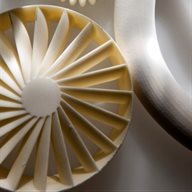
Additive Manufacturing (AM) or 3D Printing is now referred to as Game Changing Technology and appears to be creating a whole new manufacturing genre. Its impact is so significant that Barack Obama President of the United States of America, in his 2013 State of the Union Speech, described it as having the potential to revolutionise the way we make things. It is estimated that this business approached £1.2 bn in 2011, including the AM systems sales, and its associated materials and services. The Technology Strategy Board (TSB) estimates that by 2020 the net worth of this field will approach £4.5 bn, and as such it is important to understand the range of technologies and applications that can arise from AM.

The concept of AM is simple. A computer geometrical (CAD) model is used to generate a numerically-controlled path to add a material layer-by-layer, building a structure bottom-upwards. For metals, the process generally comes in a number of variants, one of which is what is commonly referred to as a powder bed method, whereby thin layers of powders (~20-100 microns) of the material to be ‘printed’ are spread using a recoater blade from a powder reservoir to a neighbouring substrate. A heat source (e.g. laser or electron beam) is used to selectively melt or sinter the powders on the substrate, only in the regions that correspond to the 2D section of the component being built. By repeating this process, the entire structure can be grown, and then extracted from the powder bed, with the surrounding un-sintered powder being recycled. The other more common variant is direct laser deposition, where a laser, electric arc, or electron beam is used to melt a wire or powders being sprayed through a nozzle to melt and deposit in ‘free-form’. The process can be used for repair applications, or hybrid additive manufacturing where structural features (e.g. bosses or lugs) can be deposited on structures to simplify the manufacturing process and to avoid whenever possible excessive machining operations. The Following picture shows the complex geometry manufactured using AM in University of Birmingham.
The powder bed method has traditionally been used to build orthopaedic and dental implants from titanium alloy, cobalt-chrome and stainless steels, but current research being undertaken at the University of Birmingham is looking into using it to build aerospace and defence titanium, aluminium, and nickel superalloy structures. For medical implants, the process offers the advantage of creating customised medical implants, that can be tailored for uncommon injuries (typically in the battlefield). This is done by manipulating MRI or CT scan data to create the geometry for an implant that will ‘fill’ the injury place (e.g. in a skull). Additionally, the process enables designing for functionality rather than manufacturability. AM liberates the designers from the constraints imposed by the manufacturing methods, enabling them to design the product based on its functional requirements rather than on how to make it. AM also provides a resource-efficient approach to produce complex netshape structures, with a potentially low buy-to-fly ratio and considerable reduction in materials waste compared to other manufacturing process for high-value materials (Ti-alloys and Ni-superalloys) especially in the aerospace structures (structural sections, landing gear, and engine parts). Following are the complex shape manufactured using metallic alloys in University of Birmingham.
Both variants of AM for metallic materials face a number of challenges to address. First, the structures built using both techniques are prone to structural integrity issues, since AM is more like a mixture of joining and casting. In fact, it is generally known that the weldability of a certain material can be used to assess its processability using AM. As such, issues like the development of structural defects (pores and cracks), distortion/residual stresses, and microstructural anisotropy (which leads to a directionality in the mechanical properties). These issues combined can be resolved or avoided through the introduction of new alloy variants that are suitable for AM, which is yet to be developed, in addition to the development of advanced metallurgical and structural assessment techniques, such as X-ray tomography. Equally, to maintain the structural and geometrical integrity of the component during deposition, the development of on-the-fly non-destructive evaluation (NDE) of the structure for detection of porosity is required to ensure the repeatability of the process.
Aside from the Process attributes, perhaps one of the greatest challenges will be around the education of designers – the process requires a complete shift in approach to take maximum advantage of its manufacturing capability.
Dr Kiran Gulia is Laser Technical and Research Manager in the Advanced Materials Processing Lab (AMPlab)